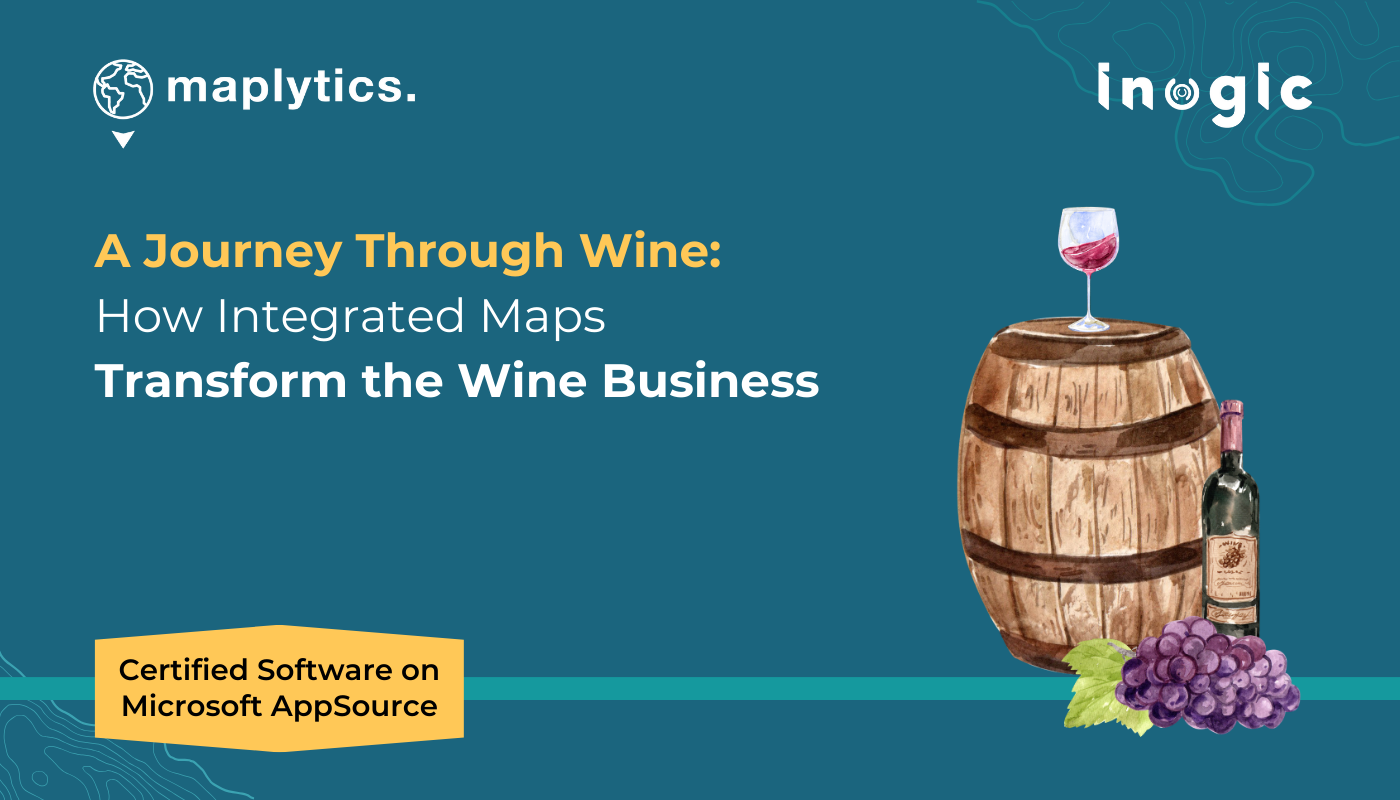Imagine standing in the heart of a vast vineyard, surrounded by rows of lush grapevines, with the sun setting over rolling hills, and the air carrying the pleasant whiff of ripe grapes. As you sip on a glass of fine wine, your guide begins to walk you through the intricate journey that transforms a simple grapefruit into an exquisite sparkly sweet drink in your hand.
But what if I told you that this entire process is not only a result of nature and craftsmanship but also cutting-edge technology? Welcome to the world of Maplytics, a certified geo-mapping and geo-analytical powerhouse seamlessly integrated with Microsoft Dynamics 365/ Dataverse/ Power Apps, revolutionizing the wine industry from plantation to retail.
Planting the Seeds
It all begins with the vineyards. For a wine business, the location of grape plantations is crucial. Maplytics helps vineyard managers visualize their plantations on a map, ensuring that soil quality, climate conditions, and terrain are suitable for grape cultivation. Using Land Area Mapping, they can ensure the nearby regions too are useful. By using heat maps, vineyard owners can analyze temperature trends, humidity levels, and soil moisture distribution across different regions before finalizing.
The vineyard manager opens a tablet, displaying a Maplytics dashboard integrated with Dynamics 365. “With this, we monitor all our vineyard locations, track the team at work, and analyze trends on the go to plan seasonal farming activities,” the guide explains. The team also uses proximity search to identify nearby suppliers for fertilizers and irrigation equipment, ensuring that the right resources reach the right vineyard at the right time.
Harvesting with Precision
As the grapes ripen, the next step is harvesting. Here, Auto Scheduling in Dynamics 365 plays a vital role. “We use Maplytics to plan and assign tasks to our field teams,” the guide says, pointing at a Bing/Azure map on his tablet showing various vineyards with color-coded markers. The software allows managers to schedule harvest days, allocate workers efficiently according to their skills, and optimize routes for transporting freshly harvested grapes to processing units.
“Without a streamlined system, delays in harvesting can affect the quality of the wine,” the guide adds. Route Optimization ensures that transportation trucks take the shortest or fastest paths, reducing travel time and preserving the freshness of the fruit. “Drivers even get real-time navigation on their mobile devices via Google Maps, Apple Maps, or Waze,” they say, demonstrating how a driver receives an alert for the optimal route.
Processing & Aging
Once harvested, the grapes move to processing facilities, where they are sorted, crushed, fermented, and aged. With Dynamics 365 territory management, winery managers can allocate different production tasks to specific units across locations. Pushpins on the map mark the facilities handling different stages of winemaking—crushing in one, fermentation in another, and aging in oak barrels in a third.
“Our warehouses are mapped out precisely using Maplytics,” the guide explains, showing a visualization of storage tanks, barrel rooms, and bottling lines. With geo-analytics, they track the availability of barrels, fermentation progress, and aging durations. If there’s a requirement for specific ingredients or equipment, they use Point Of Interest Location to find the nearest suppliers and expedite procurement.
Distribution & Transportation
Once bottled, the wine needs to reach distributors, retailers, and eventually, consumers. This is where fleet management with Maplytics comes into play. The organization’s logistics team uses route optimization to determine the best routes for delivery trucks, ensuring timely transportation of wine to distribution centers.
The guide points to a delivery truck on the Maplytics interface. “Each truck’s route is optimized, ensuring deliveries avoid traffic congestion and delays,” they explain. The system also allows logistics managers to plot all retail stores and distribution centers on a map, ensuring that delivery schedules align with demand.
“Even during peak seasons, like holidays, we use Maplytics to dynamically adjust routes based on demand and weather conditions,” they add. If a truck encounters an unexpected delay, the system automatically reroutes it to ensure smooth deliveries while keeping us updated.
Retail & Customer Engagement
The final step is getting the wine into the hands of consumers. Maplytics helps sales teams identify potential customers and retailers based on geographic location. Using Radius/Proximity Search, sales representatives can find and reach out to wine stores, hotels, and restaurants in a defined area.
“When we launch a new wine variety, our sales team uses Maplytics to target high-demand regions,” the guide explains. The heat maps show sales trends, helping managers identify the most lucrative areas for promotions and marketing campaigns. With check-in/check-out features, sales reps can log their visits to stores, ensuring that they stay on track with customer engagements.
A Perfect Blend of Tradition & Technology
As the tour comes to an end, the guide raises their glass. “In winemaking, precision, timing, and quality are everything. Thanks to Maplytics, we bring efficiency to every step of the process—from planting grapes to delivering the finest wines to your table.”
For any wine business looking to optimize operations, Maplytics is the ultimate geo-mapping solution.
What’s More?
Maplytics is like water that can be molded into any role. It makes Bing Maps and Azure Maps integration within Dynamics 365 look seamless. Radius Search, Route Mapping, and more have become super easy to use. To get more acquainted and experience it first-hand, one can write to crm@inogic.com To investigate the product further, with a personalized demo within Microsoft Dynamics 365 CRM / Dataverse get in touch with the team. For applied knowledge, do visit our Website or Microsoft AppSource. One can hop on to the detailed Blogs, Client Testimonials, Success Stories, Industry Applications, and Video Library for a quick query resolution. You can check out our technical tutorial video series #KnowYourMaplytics here and for fun Tips & Tricks about Maplytics have a look at our series #ProAtMaplytics here. Technical docs for the working of Maplytics are also available for reference.
You can also leave us a review or write about your experience on AppSource or G2 Website.











